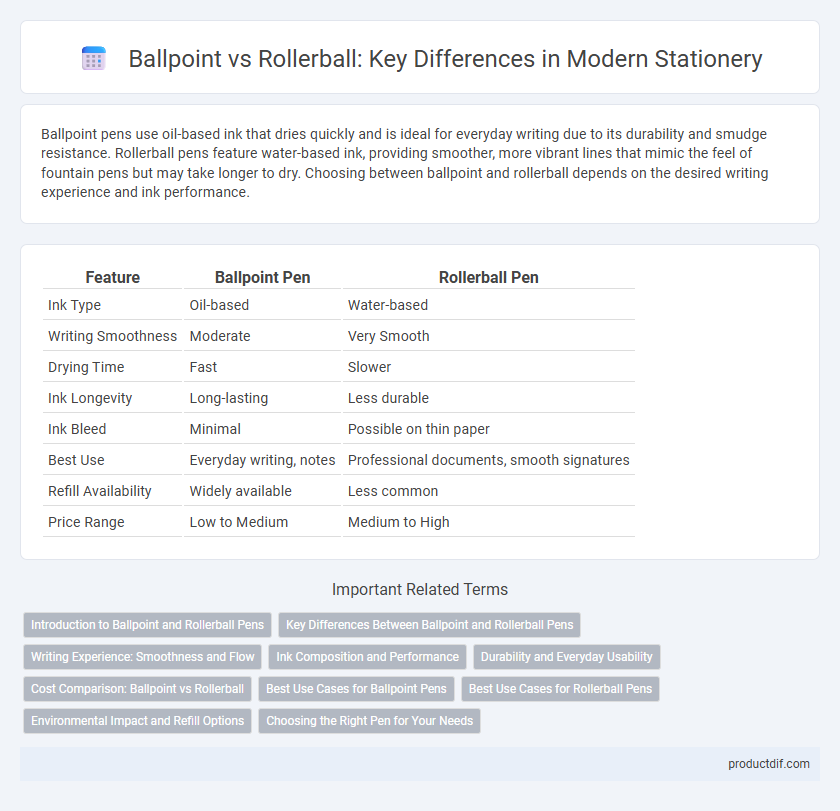Ballpoint pens use oil-based ink that dries quickly and is ideal for everyday writing due to its durability and smudge resistance. Rollerball pens feature water-based ink, providing smoother, more vibrant lines that mimic the feel of fountain pens but may take longer to dry. Choosing between ballpoint and rollerball depends on the desired writing experience and ink performance.
Table of Comparison
| Feature | Ballpoint Pen | Rollerball Pen |
|---|---|---|
| Ink Type | Oil-based | Water-based |
| Writing Smoothness | Moderate | Very Smooth |
| Drying Time | Fast | Slower |
| Ink Longevity | Long-lasting | Less durable |
| Ink Bleed | Minimal | Possible on thin paper |
| Best Use | Everyday writing, notes | Professional documents, smooth signatures |
| Refill Availability | Widely available | Less common |
| Price Range | Low to Medium | Medium to High |
Introduction to Ballpoint and Rollerball Pens
Ballpoint pens use oil-based ink that dries quickly, making them ideal for everyday writing with smooth, consistent lines and minimal smudging. Rollerball pens feature water-based or gel ink, offering a smoother writing experience and more vibrant lines but require faster drying times. Both pen types serve different preferences in writing feel and ink performance, catering to diverse professional and personal needs.
Key Differences Between Ballpoint and Rollerball Pens
Ballpoint pens use oil-based ink that dries quickly and is less prone to smudging, making them ideal for everyday writing tasks requiring durability and longevity. Rollerball pens utilize water-based ink that flows more smoothly and produces vibrant, saturated lines, offering a writing experience closer to fountain pens. The main differences lie in ink composition, drying time, and writing smoothness, influencing pen selection based on writing style and paper type.
Writing Experience: Smoothness and Flow
Ballpoint pens use a thicker, oil-based ink that offers controlled, consistent lines but may feel slightly resistant on paper, making them ideal for everyday writing with less smudging. Rollerball pens feature water-based ink, which delivers a smoother and more fluid writing experience, resembling the feel of a fountain pen with vibrant, sharp lines but can bleed through thinner paper. Choosing between ballpoint and rollerball depends on preference for smoothness and ink flow versus durability and quick drying.
Ink Composition and Performance
Ballpoint pens use oil-based ink that dries quickly and resists smudging, making them ideal for everyday writing on a variety of paper types. Rollerball pens feature water-based or gel ink that produces smoother, darker lines but may take longer to dry and can bleed through thinner paper. The ink composition directly influences the writing performance, with ballpoint offering durability and rollerball providing enhanced fluidity and precision.
Durability and Everyday Usability
Ballpoint pens use oil-based ink, making them highly durable and less prone to smudging, ideal for everyday use on a variety of paper types. Rollerball pens feature water-based ink that offers smoother writing and vibrant lines but may dry slower and require more careful handling to prevent ink bleed-through. For consistent, long-lasting performance in daily tasks, ballpoint pens generally provide superior reliability and minimal maintenance.
Cost Comparison: Ballpoint vs Rollerball
Ballpoint pens generally offer a more budget-friendly option with ink cartridges that last longer and require less frequent replacement compared to rollerball pens. Rollerball pens use water-based ink that provides a smoother writing experience but tends to run out faster, increasing overall refill costs. For frequent writers or bulk purchases, ballpoint pens provide a significant cost advantage, while rollerball pens may justify higher expenses for premium writing quality.
Best Use Cases for Ballpoint Pens
Ballpoint pens excel in everyday writing tasks due to their quick-drying, smudge-resistant ink that performs well on various paper types. They are ideal for note-taking, filling out forms, and writing in environments where durability and longevity are essential. Their low maintenance and cost-effectiveness make ballpoints a preferred choice for schools, offices, and on-the-go usage.
Best Use Cases for Rollerball Pens
Rollerball pens excel in smooth, fluid writing ideal for extended note-taking, journaling, and signature work due to their water-based ink and finer tip. Their ink flows more easily than ballpoint, minimizing hand fatigue and producing vibrant, precise lines on standard and high-quality paper. Rollerball pens are best suited for professionals, students, and artists who require consistent ink flow and a comfortable writing experience.
Environmental Impact and Refill Options
Ballpoint pens use oil-based ink that dries quickly and generally lasts longer, reducing waste through less frequent refills, whereas rollerball pens contain water-based ink that often runs out faster, leading to more frequent replacements. Many ballpoint pens offer widely available refill cartridges made from recyclable materials, promoting sustainability by extending the life of the pen body. Rollerball refills are less standardized and may generate more disposable plastic, increasing environmental impact relative to ballpoint options.
Choosing the Right Pen for Your Needs
Ballpoint pens use oil-based ink that dries quickly and lasts longer, making them ideal for everyday writing and reliability on various paper types. Rollerball pens feature water-based ink that flows smoothly and delivers vibrant colors, preferred for detailed writing and artistic projects. Selecting the right pen depends on your writing style, ink preference, and the paper quality you commonly use to ensure comfort and optimal performance.
Ballpoint vs Rollerball Infographic

 productdif.com
productdif.com